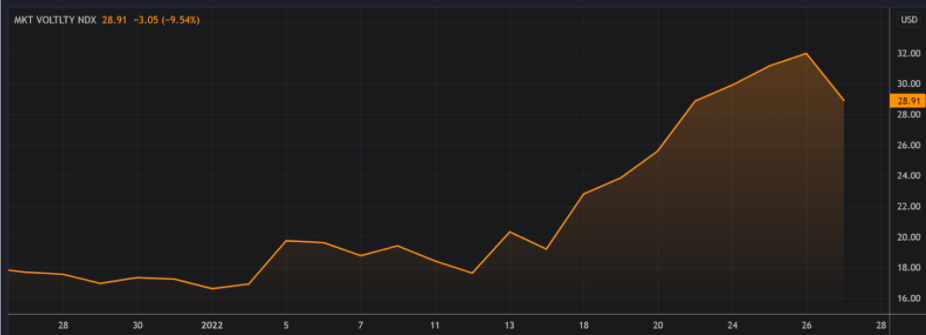By Renée Friedman, PhD
The week in summary:
Welcome to Macro Insights #13. This week saw market volatility rise in anticipation of the US Federal Reserve (the Fed) meeting decision on Wednesday with tech stocks particularly affected. Ongoing concerns over the effect the Omicron variant is having on growth as well as the growing geopolitical tensions arising from NATO’s decision to send ships and fighter jets to battalions in Lithuania, Latvia, Estonia and Poland, and the US putting 8500 troops on alert and issuing a letter to Russia’s President Vladimir Putin about NATO expansion has also contributed to market volatility as shown in the Market volatility index (VIX) chart below.

On Wednesday the Fed decided to hold the target range for the benchmark policy rate unchanged at zero to 0.25% as expected. With inflation well above 2% and an extremely tight labour market, the FOMC said on Wednesday that it expects it will soon be appropriate to raise the target range for the federal funds rate. During the press conference following the announcement, Fed Chairman Jerome Powell said the Fed was ready to raise rates in March and didn’t rule out moving at every meeting. In a separate statement, the Fed said it expects the process of balance-sheet reduction will commence after it has begun hiking. A rate increase would be the central bank’s first since 2018. Powell said that inflation could remain higher than is currently expected but that the Fed had not yet discussed how quickly to shrink the balance sheet. He said there was room to raise rates without hurting the labour market given the record number of job openings, the high quit rate, and increasing wages. The dollar strengthened after the announcement.
The growing geopolitical risk from the Russia-Ukraine border issues, threats to infrastructure in the United Arab Emirates and struggles by OPEC+ to hit its targeted monthly output increase are also contributing to rising oil prices. Brent futures are rising and currently stand at about $90/barrel.
The IMF lowered its world growth forecast for 2022, citing weaker prospects for the U.S. and China along with persistent inflation due to ongoing supply chain disruptions and high energy prices continuing in 2022. It now projects global growth this year at 4.4%, that’s 0.5% lower than forecast in October. Global growth is expected to slow to 3.8 % in 2023 and is conditional on adverse health outcomes declining to low levels in most countries by end-2022, assuming vaccination rates improve worldwide and therapies become more effective.
Things to look out for this coming week:
- In Europe on Friday look out for French and German GDP as well as Eurozone Business Climate and Consumer Confidence data. On Tuesday there is German retail sales data, French CPI, as well as Spanish, French, German and Italian Markit manufacturing PMIs and German and Eurozone unemployment data. On Thursday there is Spanish, Italian, Eurozone Markit Services PMI. There is also German Markit PMI Composite data, French PMI Composite data, and Eurozone Markit PMI Composite and Markit Manufacturing PMI data. European markets will be looking to the ECB meeting on Thursday to see if the ECB has finally decided that inflation is not “transitory” and if it will at least suggest the option of further tightening measures.
- In the US on Friday there is Core Personal consumption expenditure price index data, Personal Income and Personal Spending data, and the Michigan Consumer Sentiment Index. On Tuesday is Markit Manufacturing PMI, the ISM Manufacturing Employment Index, the ISM Manufacturing PMI, ISM Manufacturing New Orders Index and ISM Manufacturing Prices Paid. On Thursday look out for initial and continuing jobs data, non-farm productivity and labour cost data, Markit PMI Composite and Markit Services PMI data, Factory orders, ISM.
- In the UK on Tuesday there is Markit Manufacturing PMI. On Thursday there is Markit Services PMI and the Bank of England interest rate decision.
It will be worth paying attention to the results of the OPEC meeting on Wednesday 2 February. OPEC, along with its allies (known collectively as OPEC+) decided to raise its output target by 400,000 barrels per day from February. Given the continuing energy price crunch and the geopolitical tensions between Western Europe, the US, and Russia, this could influence how sticky inflation may prove in Europe, i.e. if production does not increase, then the price of energy in Europe will remain high, contributing to inflation levels above the ECB target.
Europe’s energy-inflation nexus
The rapid rise in energy prices over the past two years following the start of the Coronavirus pandemic has undoubtedly fed into inflation as it has raised the cost of the manufacture and delivery of goods and services. As has been well documented, the rise in energy prices was caused by a number of factors including increasing demand as economies reopened, low European energy stocks, weather events in the US hitting exports and lower than expected wind generation rates in the UK and the Netherlands, advancing climate change policies towards Net Zero and related “greenflation”, and geopolitical events.
Also over the past two years much focus has been on the increase in overall inflation globally and the impact on growth. It has resulted in many debates as to how quickly can and should central banks act. As was made clear this past week, the world’s biggest central bank, the US Federal Reserve (the Fed) is willing to act and even more quickly than it suggested in its December meeting although it does still see inflation moderating in the medium term. This coming week it will be the European Central Bank’s (ECB) turn to think about inflation and the contributors to it, including energy prices. Up until now it has persistently insisted that this rise in inflation is only transitory and that energy prices in particular will fall later this year. The question is whether this is as truly correct in the European context as it is in the American?
One of the big differences between the US and Europe is the fact that the Eurozone is a net importer of energy while the US is a net exporter. Therefore, geopolitical events such as those currently taking place in Russia and Ukraine which threaten to cut off gas supplies from Russia, the ongoing Iran nuclear deal discussions, the conflict between Algeria and Morocco, and the bombing of pipelines in the UAE all have the propensity to have greater impact on energy prices within Europe and to inflation levels across Europe. The other, longer term factor that tightens the energy inflation nexus for Europe in a way that it doesn’t in the US, is the Eurozone’s legal commitment to achieving net zero. This is reflected in the EU’s green energy transition requirements, particularly in the use of its emission trading system (ETS), which sets the amount of greenhouse gases that can be emitted by various economic sectors such as manufacturing, electricity or chemicals. The amount of emissions allowances is set by the EU and is reduced each year, thereby increasing their price. In the summer of 2020 the EU stepped up its emission reduction target for 2030 from 40% to 55%. This meant that the ETS had to be adjusted to make it consistent with the new climate goals. The price of emissions in Europe increased almost 3 fold: from an average of 30 euros per tonne of equivalent CO₂ (€/TCO₂) in 2020 to about €90/TCO today. In addition there is also the EU’s fit for 55 programme which is also part of the EU’s green deal. According to the European Parliament it promises to adapt existing climate and energy legislation to meet the new EU objective of a minimum 55 % reduction in greenhouse gas (GHG) emissions by 2030. One element in the fit for 55 package is the revision of the Renewable Energy Directive (RED II). Under RED II, the EU is currently obliged to ensure at least 32 % of its energy consumption comes from renewable energy sources (RES) by 2030. The revised RED II strengthens these provisions and sets a new EU target of a minimum 40 % share of RES in final energy consumption by 2030. This revision is currently under discussion in the Council of the EU. In short, the EU has legislated that energy used across the EU comes from renewable sources without the necessary amounts of renewable energy or technology being available yet. This means that while Europe continues to close down its coal mines and its nuclear stations to meet these ETS targets and awaits the development of renewable energy resources that can meet its current (and growing) needs, it will have to import more energy from existing fossil fuel and other energy sources, thus driving up the price of these resources further and contributing to overall inflation for longer. As noted by Isabel Schnabel, a member of the executive board of the European Central Bank (Bloomberg greenflation), “greenflation” is real and it is not transitory. The wider ECB board may wish to consider this when it makes its announcement next week about just how transitory, or not, Europe’s inflation will really be.
DISCLAIMER: While every effort has been made to verify the accuracy of this information, EXT Ltd. (hereafter known as “EXANTE”) cannot accept any responsibility or liability for reliance by any person on this publication or any of the information, opinions, or conclusions contained in this publication. The findings and views expressed in this publication do not necessarily reflect the views of EXANTE. Any action taken upon the information contained in this publication is strictly at your own risk. EXANTE will not be liable for any loss or damage in connection with this publication.
Questo articolo viene fornito all'utente soltanto a scopo informativo e non deve essere considerato come un'offerta o una sollecitazione di un'offerta di acquisto o di vendita di investimenti o servizi correlati che possono essere qui menzionati.






